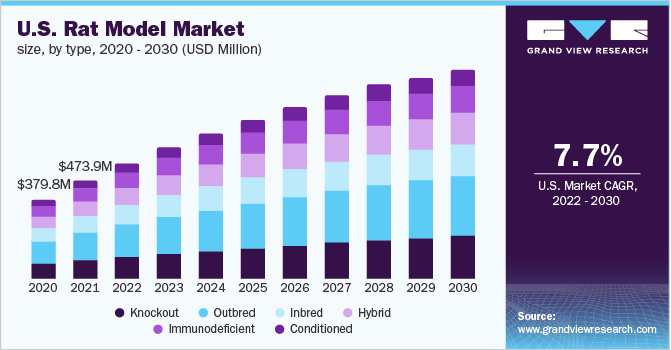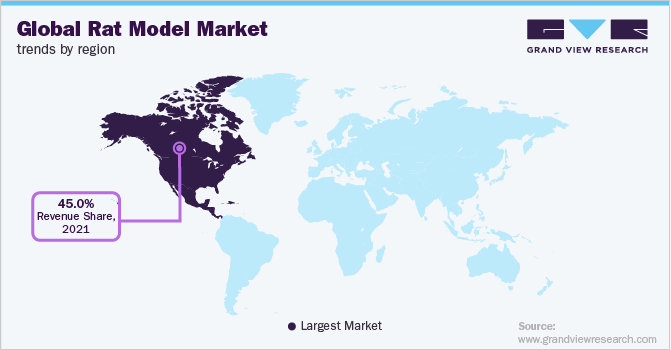Rat Model Market Growth & Trends
The global rat model market size is expected to reach USD 2.41 billion by 2030, according to a new report by Grand View Research, Inc., expanding at a CAGR of 7.81% from 2022 to 2030. Genetically modified organisms are extensively used in research for identifying potential therapeutic targets and further validation of the same. The extensive healthcare-based research has driven the market for understanding diseases and genetic illnesses of humans.

During the COVID-19 outbreak, researchers were focused on understanding the pathogenesis and transmission of the SARS-CoV2 virus by using the readily available animal model in addition to in-vitro and ex-vivo culture systems. These models also helped in the evaluation of vaccines and antivirals for the treatment. Companies creating transgenic animals used this as a perfect opportunity to provide the scientific community with genetically modified rats for evaluation of SARS-Cov2 entry. For example, in 2020,Envigo created the hACE2 knockinrat model through CRISPR-based technology. ACE2 serving as a primary receptor facilitates the entry of the SARS-CoV2 virus and is being investigated as a potential preventative target.
Animal models continue to be significant tools for preclinical testing of potential therapeutics and understanding disease mechanisms. Increased spending on research and growing number of clinical trials are the key factors contributing to the market growth. The rising incidence of genetic diseases globally and the surge in the use of animal species to advance various groundbreaking therapies are expected to further propel the market growth. Post completion of The Human Genome Project in 2003, there have been evident advancements in synthetic and molecular biology for understanding the genetic basis of diseases. These advanced technologies and products have also made it easier to create genetically engineered models (GEM) of rats, wherein different types such as knockout, outbred, inbred, and conditioned are now available in the market.
The market is expected to observe direct competition from the mouse/mice model. The mice models have been long preferred due to their small sizes and they offer economic as well as more established choices for discovery and early stage research. However, the vast use of gene editing tools in rats and the similarity of rat and human genomes make the rat model suitable for genetic manipulation and handling of experiments, thus fueling the market expansion.
Request a free sample copy or view report summary:
Rat Model Market Report
Report Attribute Details
Market size value in 2022 — USD 1.32 billion
Revenue forecast in 2030 — USD 2.41 billion
Growth rate — CAGR of 7.81% from 2022 to 2030
Base year for estimation — 2021
Historical data — 2018–2020
Forecast period — 2022–2030
Rat Model Market Report Highlights
- By type, outbred rat held the largest share in 2021. This is due to the physiological similarity of gene changes in outbred rats as in humans, which attributes to a disease phenotype
- By technology, other technologies (CRISPR/Cas, ZFN, and more)accounted for the largest share in 2021. The advent of genome editing tools has led to custom rat model creation according to the research application, thus contributing to the market demand
- By service, the breeding segment dominated the market in 2021. This is due to the high demand for multiple rat models during experiments to assess genetic variations among a population pool
- By application, in 2021, toxicology held the largest share. Owing to the demand for medications and therapeutics, toxicology studies in rats help analyze various factors such as dosing and route of administration during preclinical stages
- By end-use, the contract research organizations held the largest share in 2021.The robust R&D settings and the multiple drug discovery programs and clinical trials are fueling the segment growth. These activities employ a wide number of rat models to mimic the human response during any treatment
- North America held the largest revenue share in 2021. Growing prevalence of diseases in this region, coupled with the focus of healthcare agencies on this, has resulted in multiple funding to academic institutes for facilitating research in rats
